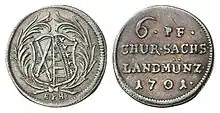State coin
During the Kipper and Wipper period and until the late 18th century, state coins (Landmünzen} in the German part of the Holy Roman Empire were those that were not minted according to the relevant imperial standard (Reichsfuß), but using a lesser alloy and thus were only fit for circulation in the territory of their mint masters. There were therefore a type of fiat coin known as a Scheidemünze.
-3915.jpg.webp)
-3914.jpg.webp)
George, Principality of Calenberg, 2 Mariengroschen state coins, 1638 (Gerhard Welter, 1462)

State coins were mostly issued in smaller denominations, but from 1687 even Brandenburg 2/3 thalers bore the designation “Brandenb. Landmünz."[1][2]
The term "state coin" (Landmünze) should not be confused with the term "national coins" or "state coinage" (Landesmünzen), which includes all the coins issued by a country.
See also
- Kipper mints (Electoral Saxony)
- Kippertaler
References
- Schrötter (1930), p. 342.
- Kroha (1997), p. 262.
Bibliography
- Kroha, Tyll (1997). Großes Lexikon der Numismatik. 2nd edn. Gütersloh: Bertelsmann Lexikon Verlag.
- Schrötter, Friedrich Frh (1970).Wörterbuch der Münzkunde. 2nd, unchanged print of the 1930 edn. Berlin: Walter de Gruyter.
External links
Wikimedia Commons has media related to Landmünze.
This article is issued from Wikipedia. The text is licensed under Creative Commons - Attribution - Sharealike. Additional terms may apply for the media files.